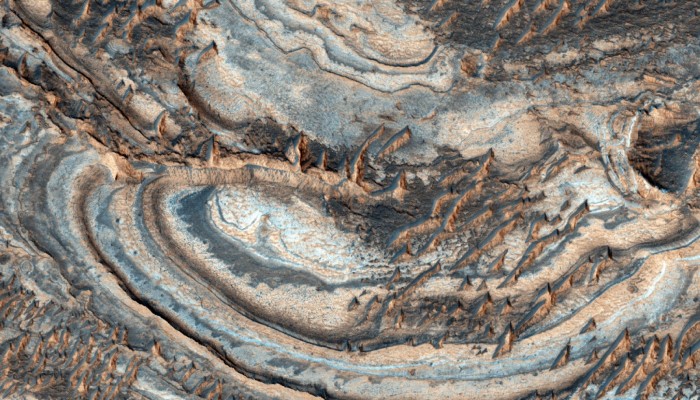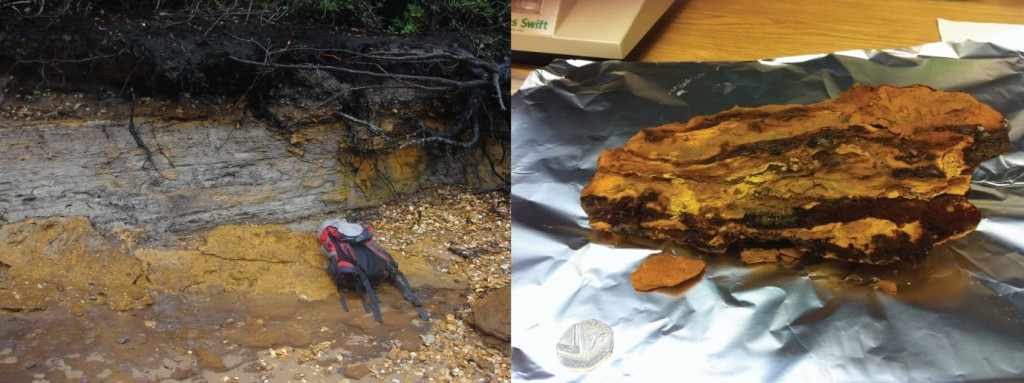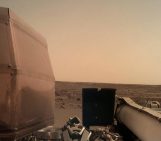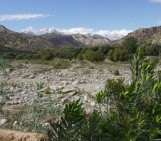
Understanding where we come from and whether Earth is the only habitable planet in the Solar System has been a long standing conundrum in science. Partly because it is our nearest neighbour, partly because of its past and current similarities with our own home, Mars, the red planet, is a likely contender in the quest for extra-terrestrial life. In this guest blog post, James Lewis, a PhD student at Imperial College London, takes a brief look at the findings of his recent research. Strap up, we are rocketing over to Mars!
Mars has always been at the forefront of our imaginations when we picture alien life and the discoveries planetary science has made in recent decades reveal that the idea of our neighbouring world having once been inhabited is not so far-fetched. Mars appears to have once been a habitable world, the question is did life ever exist there? This is one of the questions that Curiosity Rover is attempting to shed more light on but results so far have been inconclusive. One potential problem is that the mineralogy of Mars might seriously disrupt experiments looking for evidence of ancient microscopic Martians. Chlorine salts have already been proven to be problematic and in research, published today, and summarised in the following article I have shown that a salt containing iron, sulfur and oxygen, known as jarosite, can also be added to the list of problematic minerals for life detection experiments.

Eberswalde Delta on Mars, evidence for an ancient persistent flow of water over an extended period of time on the Martian surface. Image Credit: NASA/JPL/MSSS.
The satellites, landers and rovers sent to Mars have started to unravel many of the mysteries of the red planet. Perhaps their most exciting discovery is that ancient Mars may have been a habitable environment for life. The Martian surface at present is extremely cold, exceptionally dry and bombarded by ultraviolet radiation. The atmosphere is at such a low pressure that liquid water would instantly vaporise. However, characteristic landforms and the presence of minerals that we know only form in water have revealed that ancient Mars had persistent surface or near surface liquid water. The presence of liquid water is exciting because it is a precursor for life and for it to persist on the surface would require a warmer thicker atmosphere.
This potentially habitable liquid water existed billions of years ago, so how can we investigate if life ever existed in these environments? If ancient Martians existed they would likely be microscopic organisms like bacteria on Earth. We could look for the fossils they might leave behind but these features would be extremely small and there are many non-biological processes that can form similar structures. The least ambiguous evidence would be to find chemical compounds that only life leaves behind. As biological molecules contain carbon they fall under a chemical class called organic compounds. However, not all organic compounds are biological. For example, asteroids and comets contain non biological organic compounds that formed in the early Solar System.
Comets and asteroids have been impacting Mars throughout its history so when we send missions to Mars we would expect to see the organic molecules delivered by impacts from outer space. The strange thing is that we haven’t. If we can’t detect compounds we know should be there, what are our chances of detecting possible organic compounds indicative of life? All that has been detected so far are very simple organic compounds with chlorine attached. Their origin is uncertain as similar compounds are used as cleaning agents on Earth and sometimes as reagents inside the rovers, so they could just be contamination. However, recent discoveries have complicated things even further; in 2008 a mineral called perchlorate was discovered on Mars. Perchlorate is very rare on Earth as it is only stable in very arid environments such as the Atacama Desert and the Dry Valleys of Antarctica. Perchlorate has now been discovered by multiple Mars’ missions so it would appear it is widespread in the extremely arid present day Martian surface.

The Phoenix Lander made the first detection of perchlorate on Mars in 2008. Dusty Martian soil can be seen in the background and on the Lander’s frame. Image Credit: NASA/JPL-Caltech/University of Arizona/Texas A&M University.
Perchlorate is a big complication in our search for organic compounds on Mars. The most common technique used to analyse samples for the presence of organic compounds is to heat materials in an inert atmosphere until organic compounds break down and go into the gas phase. The chemical composition of this gas can then be analysed. For example, on the Curiosity rover the gas passes from the sample oven into a and then a mass spectrometer, which separates out the constituent gases and identifies them. The problem with perchlorate is that it breaks down at low temperatures, in fact just at the temperatures that organic molecules would start to break down and be detectable. Perchlorate releases oxygen and chlorine when it thermally decomposes. Oxygen will react with, and break down, organic compounds into carbon dioxide and water. So it will greatly reduce the instrument’s ability to detect organic molecules if it is present in the sample heating oven. The simultaneous release of chlorine by perchlorate could also chemically alter the products of heating experiments. This may explain why so far we have only detected simple chlorinated organic molecules on Mars.

Like previous missions to Mars, Curiosity is detecting only simple organic compounds with chlorine attached. Image Credit: NASA/JPL-Caltech/MSSS
I wanted to investigate the question as to whether perchlorate is the only mineral that might have a negative influence on our search for organic compounds on Mars. I analysed a group of minerals called sulfates. They contain sulfur and oxygen in the form SO4 and include common minerals such as gypsum. When sulfates thermally break down they release sulfur dioxide and oxygen, so they have the potential to be problematic like perchlorate. However, most break down at very high temperatures (above 1000 °C), which is sufficiently high not to interfere with the release of organic molecules from samples during heating experiments. However, iron sulfates start to break down at dramatically lower temperatures. They can decompose to give off sulfur dioxide and oxygen from around 500 °C. This is around the same temperatures that large complex organic molecules might start to break down and be detectable. I was particularly interested in an iron sulfate called jarosite, as it has been detected on Mars, including recent detections by Curiosity Rover, and forms in wet acidic conditions. It’s therefore indicative of ancient wet environments that existed on Mars and may have once been inhabited by microorganisms, as similar environments on present day Earth, such as Río Tinto in Spain are a habitat for acid resistant bacteria.
I conducted fieldwork on a small island in the south of the United Kingdom called Brownsea Island. If you walk along the southern coast of Brownsea you will often see crusts of a soft yellow mineral on the short cliffs. This is jarosite, it grows here because the clay rich rocks that make up the cliff face contain the iron and sulfur mineral pyrite, pyrite reacts with water and the atmosphere to form jarosite. The geology here is a perfect case study as the rocks also contain a tough form of organic matter called lignite, a low rank of coal. I crushed the sample into a powder so that I had a mix of jarosite, clay and organic compounds. I then heated this powder at different temperatures to see if I would be able to detect the organic compounds contained in the sample. Unfortunately all I could detect was carbon dioxide, carbon monoxide, water and sulfur dioxide. The first three are compounds that you would expect to detect if organic matter was breaking down and reacting with oxygen and the sulfur dioxide indicated that the jarosite was thermally decomposing. When a sulfate breaks down we know that sulfur dioxide is paired with oxygen but when I heated this sample the oxygen wasn’t detectable. It had been consumed by reacting with organic compounds and breaking them down. From these results jarosite can now be added to the list of problematic minerals on Mars, alongside perchlorate.

Jarosite is a soft yellow mineral and can be seen growing on the clay rich cliffs of Brownsea Island, UK. As it is an iron mineral it can rust if exposed at the surface long enough in wet conditions. The orange-brown layer at the base of the cliff and the dark patches in the hand sample are rust. Image Credit: James Lewis.
Jarosite is indicative of environments that may have been habitable for life so simply avoiding it is not a satisfactory solution. Though it has a major negative influence on organic detection experiments some interpretation may still be possible. If sulfur dioxide and carbon dioxide peak at the same time in Curiosity Rover data, from a sample known to contain jarosite, it may be evidence that organic matter was present and reacting with oxygen. Unfortunately it is not always the case that a carbon dioxide peak means the presence of organic matter. Minerals known as carbonates contain carbon and oxygen in the form CO3. When carbonates thermally decompose they produce carbon dioxide. Therefore the chance of a carbonate being the source of carbon dioxide seen in Curiosity Rover data must be considered. Fortunately Curiosity has the ability to perform an assessment of the mineralogy it is adding to its heating ovens for analysis, so the presence of carbonates can be checked.
Identifying which rock units on Mars might contain abundant organic compounds would be of great use to future missions that might return samples to the Earth where a whole suite of laboratory techniques can be employed on samples without the tight space and energy constraints of a rover or lander.
My research is published online today in the journal of Astrobiology and will be free for all to read once the open access application is processed.
By James Lewis, PhD Researcher at Imperial College London
References
Atreya, S.K., Mahaffy, P.R., and Wong, A.: Methane and related trace species on Mars: Origin, loss, implications for life, and habitability, Planetary and Space Science, 55, 358-369, doi:10.1016/j.pss.2006.02.005, 2007.
Glavin, D.P., Freissinet, C., Miller, K.E., et al.: Evidence for perchlorates and the origin of chlorinated hydrocarbons detected by SAM at the Rocknest aeolian deposit in Gale Crater, Journal of Geophysical Research, Planets Vol. 118, 1955-1973, doi:10.1002/jgre.20144, 2013.
Mahaffy, P.: Exploration of the Habitability of Mars: Development of Analytical Protocols for Measurement of Organic Carbon on the 2009 Mars Science Laboratory, Space Sci. Rev 135, 255-268, doi:10.1007/978-0-387-77516-6_18, 2008.
Ming, D.W., Archer, P.D., Glavin, D.P., et al.: Volatile and Organic Compositions of Sedimentary Rocks in Yellowknife Bay, Gale Crater, Mars. Science, 343, 1245267, doi:10.1126/science.1245267, 2013.




